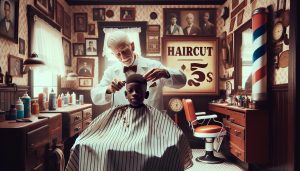The transition of Walter Baldwin from the beloved role of Floyd the Barber in “The Andy Griffith Show” has intrigued fans for decades. Understanding this change is essential not just for television history enthusiasts but also for anyone curious about the complexities behind character casting and audience engagement. Baldwin’s departure raises questions about the impact of actor choices on iconic television characters and the narratives that unfold from them. What led to this decision, and how did it shape the show’s legacy? Dive into this exploration to uncover the reasons behind Baldwin’s replacement, revealing insights about the entertainment industry, audience expectations, and the delicate balance of sustaining beloved characters while evolving narratives. This journey into TV history will deepen your appreciation for the artistry behind your favorite shows.
The Legacy of Floyd the Barber: An Introduction to the Character
Floyd the Barber, a beloved character from “The Andy Griffith Show,” transcends the typical supporting role to become an iconic figure representative of a simpler, timeless era. Known for his slight stutter and affable demeanor, Floyd provided both comic relief and a sense of community within the fictional town of Mayberry. His character was more than just a barber; he was a confidant to the local townsfolk, embodying the essence of small-town charm and warmth.
The character was portrayed by Walter Baldwin from the show’s inception in 1960 until Baldwin’s departure for personal reasons in 1961. Baldwin’s natural ability to capture the quirky, earnest qualities of Floyd made him a memorable presence on screen. His interactions with main characters like Sheriff Andy Taylor showcased not only his comedic timing but also the underlying wisdom that a barber’s chair can often provide. Viewers connected with Floyd’s light-hearted banter, offering a sense of calm and familiarity in a sometimes chaotic world.
Despite Baldwin’s unique contributions to the character, the transition to a new actor, Howard McNear, led to a nuanced evolution of Floyd’s personality. This change sparked discussions about the impact of casting on character legacy and the challenges actors face when stepping into established roles. McNear’s portrayal maintained the gentleness of Floyd while adding his flavor to the character, illustrating how character development can occur beyond a single actor’s performance.
The legacy of Floyd the Barber continues to resonate with audiences today, reflecting the charm of Mayberry and reminding viewers of the importance of community ties. His character, with all its endearing quirks, remains a beloved symbol of the show, underscoring how essential supporting characters are in enriching the narrative and deepening the connection viewers have with a television series.
Walter Baldwin’s Impact on Floyd’s Original Portrayal
Walter Baldwin’s portrayal of Floyd the Barber laid a foundational charm that resonated deeply with audiences from the very first episode of “The Andy Griffith Show.” His ability to embody a character who was both endearing and relatable established a warmth within the fictional town of Mayberry that became a hallmark of the series. With a nuanced performance enriched by a light stutter and a friendly demeanor, Baldwin breathed life into Floyd, making him much more than just a supporting character. He was a confidant, a counselor, and a gentle observer of small-town life, whose snippets of wisdom often came through during comedic exchanges.
Baldwin’s interactions portrayed a unique blend of humor and sincerity; whether he was advising Sheriff Andy Taylor on town matters or engaging in quirky conversations with other townsfolk, his character stood for the easiness of community connections. His small-town charm was meticulously crafted, ensuring that audiences viewed Floyd as a beloved staple in their lives. Baldwin’s performance sparked relatability, drawing viewers into the character’s world through both laughter and poignant moments, often exemplifying the value of friendship and understanding.
When Baldwin left the show, his absence was palpable, primarily due to the indelible mark he left on the character of Floyd. The original portrayal was pivotal not just for the character’s development, but also for how it influenced audience perceptions of men in their roles within the community, often portrayed as wise yet approachable figures. This duality of his performance was critical in showcasing the essence of everyday life in Mayberry, leaving a legacy that would influence how supporting characters are built and appreciated in television storytelling.
The transition to Howard McNear brought a different energy to Floyd, which raised discussions about the elasticity of character identity in television. Baldwin’s foundational work allowed for this evolution, demonstrating how one portrayal can set the groundwork for another actor to build upon, thereby ensuring Floyd’s legacy would continue to thrive while adapting to new actor dynamics. Through Baldwin’s impact, the character of Floyd the Barber remained a beloved part of television history, embodying the spirit of community life that resonates with viewers across generations.
Reasons Behind Walter Baldwin’s Departure from the Role
Walter Baldwin’s departure from his role as Floyd the Barber was a topic of considerable interest among fans of “The Andy Griffith Show.” Many were left wondering why such a beloved character would see a change in actors, especially given Baldwin’s strong connection with the audience. The reasons behind this transition were primarily related to health issues he faced during the series.
Baldwin suffered from health complications that increasingly hampered his ability to perform. Specifically, he struggled with a condition that required significant medical attention, ultimately impacting his ability to fulfill the demands of a regular television series. This situation left the show’s producers with a challenging decision: either allow the character of Floyd to fade away or find a suitable replacement to continue the legacy of this charming barber. The necessity to keep the character integral to the show’s fabric led to the decision to recast.
Notably, casting changes in television casts can lead to a variety of audience reactions; however, in Baldwin’s case, his health challenges made the transition more understandable for fans. Many viewers expressed support for Baldwin and his health journey while simultaneously showing curiosity and hope regarding how a new actor might bring a different flavor to the character. Ultimately, the decision to replace Baldwin was reflective of the show’s commitment to maintaining continuity in its storytelling, allowing Floyd the Barber to remain an important figure in the delightful chaos of Mayberry.
As a result, Baldwin’s departure opened the door for Howard McNear to step into the role, bringing his own interpretation while building on the solid foundation Baldwin had established. This change serves as a reminder of the complexities involved in casting decisions, especially in long-running series where audience loyalty and character integrity often intertwine.
The Role of Floyd the Barber in ‘The Andy Griffith Show
Floyd the Barber was not merely a supporting character on “The Andy Griffith Show”; he embodied the heart and humor of Mayberry through his distinctive personality and interactions with other characters. As the town barber, Floyd served as a confidante and comic relief, often providing a humorous lens through which the small-town life was portrayed. His eccentric demeanor and unique way of speaking made him a beloved figure in the community, often offering lighthearted commentary on the happenings around him. This role became an integral part of the show’s charm, showcasing the warm and quirky essence of small-town America during a transformative period in television history.
The character of Floyd evolved over time, reflecting the shifting dynamics of the series. He was characterized as a kind-hearted, albeit bumbling, barber who frequently found himself in comedic situations, whether it was dealing with clients or engaging in conversations with other Mayberry residents. What set Floyd apart was his ability to ground these interactions with genuine warmth, making him a favorite among viewers. His dialogue often straddled the line between wisdom and foolishness, contributing to many memorable moments that resonated deeply with the audience.
Moreover, Floyd’s role was pivotal in demonstrating the sense of community that defined the show. As a frequent participant in town meetings and local gossip, his character acted as a lens for the audience to glean insights into the life and culture of Mayberry. The character’s haircuts served more than just practical purposes; they were catalysts for discussions about relationships, aspirations, and everyday troubles, emphasizing the importance of connection and support in times of need.
When Walter Baldwin stepped away from the role due to health concerns, the decision to replace him came with challenges. The producers needed to find an actor who could capture Floyd’s essence while also allowing the character to continue contributing to the storyline. This transition underlined the complexity of maintaining character integrity in long-running shows. The subsequent portrayal of Floyd by Howard McNear presented an opportunity for the character to grow while adhering to the foundational attributes that audiences had come to love. This intricate balance between consistency and evolution highlighted the role Floyd played not just as a barber, but as a vital member of the Mayberry community, whose tales and tribulations mirrored the lives of those watching at home.
Comparing Walter Baldwin’s Performance to His Successor
Walter Baldwin’s portrayal of Floyd the Barber was characterized by a unique blend of nuance and humor that captured the essence of small-town America. His acting style brought a charming, bumbling quality to Floyd, allowing viewers to relate easily to the character’s quirks and oddities. Baldwin’s Floyd was invested in the community, serving as a confidant and an observer of Mayberry’s life, which made him a beloved character. His performance relied heavily on an expressive demeanor combined with a distinctive vocal inflection, which enhanced his quirky charm. It was Baldwin’s ability to deliver lines with a perfect mix of sincerity and folly that created many memorable moments within the series.
In contrast, Howard McNear, who took over the role following Baldwin’s departure due to health issues, brought his own distinct flair to Floyd. While his performance retained the foundational elements established by Baldwin, McNear introduced a sharper comedic timing and a slightly more confident demeanor. His portrayal allowed Floyd to grow into his role, often adding a layer of irony to his interactions. McNear’s ability to play off other characters-especially Andy Taylor and Barney Fife-enhanced the comedic aspects of the show, emphasizing Floyd’s place in the town’s social fabric while allowing for greater depth in his character development.
When comparing both performances, it’s clear each actor brought valuable, yet different attributes to Floyd. Baldwin’s interpretation was steeped in warmth and an endearing naivety, while McNear’s approach leaned more towards a lively, quick-witted barber who was still intrinsically connected to the community. This shift resulted in a different but complementary dynamic within the ensemble, demonstrating how a character can evolve while remaining true to its roots. Ultimately, both portrayals have become iconic, allowing the character of Floyd to continue resonating with audiences across generations.
Cultural Significance of Floyd the Barber: A Retrospective
The character of Floyd the Barber not only provided comedic relief in ‘The Andy Griffith Show,’ but he also represented a deeper cultural connection to the simplicity and charm of small-town America. Floyd embodied the everyday man, someone who was both a confidant and a witness to the lives of the citizens of Mayberry. His character resonated widely with audiences, showing that even the most seemingly mundane places can have their own vibrant stories. This cultural resonance illustrates how television can reflect societal values and the importance of community, especially during a time when America was striving for connection in a rapidly changing world.
Floyd’s significance can be traced through his evolution from Walter Baldwin’s portrayal, who infused the role with warmth and a bumbling sincerity, to Howard McNear’s interpretation, which introduced sharper comedic timing and a more dynamic presence. Each actor brought a unique interpretation of the character that mirrored shifts in societal expectations and comedic styles of their time, showcasing how characters can evolve while maintaining core connections to their origins. This evolution not only kept the show fresh but also highlighted the importance of adaptability in storytelling, allowing Floyd to remain relevant to new generations of viewers.
The cultural imprint of Floyd the Barber can also be seen in how he influenced the depiction of barbers in media. Beyond his humorous character, Floyd served as a local sage, offering advice and insights to the residents of Mayberry, thus reinforcing the barber’s traditional role as a community cornerstone. This connection has lingered in popular culture, where barbershops are often depicted as safe spaces for discussion and camaraderie, contributing to Floyd’s legacy as a relatable, cherished figure.
Ultimately, the significance of Floyd the Barber extends beyond his on-screen antics. He represents a blend of nostalgia and authenticity that resonates deeply in today’s fast-paced world, inviting reflections on community, humor, and the beauty of everyday life. His journey from Baldwin to McNear illustrates the power of storytelling and character development within television history, making him a benchmark in television portrayals that continues to inspire future generations of characters.
Behind the Scenes: Production Decisions and Casting Changes
In the realm of television history, casting changes can often stir debate among fans and creators alike. The transition from Walter Baldwin to Howard McNear as Floyd the Barber in ‘The Andy Griffith Show’ is no exception. Baldwin originally brought a unique charm and gentleness to the character, embodying the everyman archetype that resonated deeply with audiences. However, circumstances surrounding Baldwin’s personal health influenced production decisions, leading to his eventual replacement.
Behind the scenes, the decision was not made lightly. Baldwin’s health began to decline, which restricted his ability to perform consistently. This created a dilemma for the show’s producers, as they sought to maintain the quality and continuity of their beloved series. In casting McNear, the production aimed to keep the character’s essence intact while allowing for a fresh interpretation. McNear’s ability to deliver sharp comedic timing significantly influenced the character’s evolution, making Floyd more dynamic and memorable as the series progressed.
This casting change highlights the adaptability required in television productions. Whenever a beloved character is recast, showrunners must balance the established persona while ensuring a seamless transition that satisfies the audience. In McNear’s case, he not only maintained the warmth originally portrayed by Baldwin but also added his own flair that captured the viewers’ attention in a new light. The successful adaptation of Floyd the Barber exemplifies how production teams can pivot effectively in response to real-world challenges, ultimately enriching the narrative and deepening audience engagement.
In conclusion, while Baldwin’s departure was propelled by circumstances beyond anyone’s control, it also opened the door for a revitalization of Floyd’s character. This informed casting decision became a testament to the enduring nature of good storytelling and the ability of television to evolve, responding to both artistic integrity and practical realities.
Audience Reactions to the Change: Reception and Criticism
While casting changes can breathe new life into a show, they often evoke a mix of excitement and trepidation from viewers. The transition from Walter Baldwin to Howard McNear as Floyd the Barber in “The Andy Griffith Show” was met with varying reactions from fans who had grown fond of Baldwin’s initial portrayal. Many viewers were attached to Baldwin’s unique charm and warm demeanor, which lent Floyd a genuine everyman quality. This bond naturally led to skepticism about how the character might change with a new actor at the helm.
Despite the initial hesitance, audiences gradually began to appreciate McNear’s take on Floyd. His ability to deliver sharp comedic timing distinguished his performance, adding layers to the character that some fans found refreshing. Viewers noted a shift from Baldwin’s more subdued, gentle portrayal to something more exuberant and animated, bringing a new dynamic to the interactions in Mayberry. The charm of Floyd remained intact, yet McNear’s punchy delivery and improvisational skill allowed the character to adapt seamlessly into the show’s evolving narrative.
However, not all responses were positive. Some longtime fans felt a sense of loss with Baldwin’s departure, believing that McNear’s portrayal strayed too far from the original character’s essence. This highlights a common sentiment in television history where passionate viewers often resist change, especially for beloved characters. Critiques often surfaced in fan letters and forums, discussing whether McNear could ever fill the shoes of the original Floyd. Yet over time, McNear earned his place, showcasing how actors can redefine characters within familiar frameworks.
Ultimately, the audience’s reaction to this casting shift illustrates the complexities of TV adaptations. It serves as a reminder that while change can be daunting, it also offers opportunities for growth and reinterpretation that can lead to new angles of storytelling. As audiences warmed to McNear’s take on Floyd, the character continued to resonate, proving that strong narrative foundations can successfully weather the turbulence of casting changes, allowing both the show and its viewers to evolve together.
The Evolution of Floyd the Barber Through the Years
The character of Floyd the Barber has undergone significant evolution throughout the history of “The Andy Griffith Show.” Initially portrayed with a gentle, understated charm by Walter Baldwin, Floyd was a relatable figure in the small town of Mayberry. Baldwin’s original portrayal emphasized warmth and sincerity, creating a barber who seemed like a friend to his clients-a confidant in their personal lives. This approach set a strong foundation for the character, endearing him to viewers and establishing his role as a comforting presence in the community.
However, with the casting change to Howard McNear, Floyd underwent a noteworthy transformation. McNear brought a heightened sense of vibrancy and comedic timing to the character, allowing Floyd to evolve into a more dynamic figure. His performance showcased an exuberance that resonated with audiences, introducing a blend of humor and complexity that revitalized the role. McNear’s take highlighted the character’s quirks and provided a fresh, energetic dynamic that reflected the evolving narrative of the show. The shift in portrayal also allowed for more situational comedy, enhancing Floyd’s interactions not just with clients but with other beloved characters in Mayberry.
Another significant aspect of Floyd’s evolution was how he mirrored societal trends and changes in television itself. As the series progressed, Floyd’s storylines became more involved with the daily happenings of the town. The character began to reflect a more significant role in community events, showcasing his adaptability in engaging with other established characters. This evolution helped to underscore the importance of small-town life and friendship that was central to the show’s appeal.
Moreover, this transformation of Floyd the Barber illustrates a broader trend seen in many television series: characters adapting to accommodate new story arcs or shifts in thematic focus. The transition from Baldwin to McNear is not merely a change in actors but a testament to the character’s resilience and the show’s ability to grow. As audiences embraced McNear’s portrayal, Floyd became a symbol of the series’ strength, showcasing how characters can not only survive casting changes but thrive, reflecting different layers of the human experience along the way.
Exploring the Aftermath: Baldwin’s Career Post-‘Andy Griffith
Walter Baldwin’s departure from his role as Floyd the Barber marked a pivotal moment in his career, leading him to explore new avenues in the entertainment industry. Following his exit from “The Andy Griffith Show,” Baldwin continued to work in television and theater, though he found it challenging to replicate the success he experienced in Mayberry. One notable project was his appearance in the 1960s series “The Dick Van Dyke Show,” where his comedic talents were showcased in various guest roles, demonstrating his versatility as an actor.
Baldwin also made significant contributions to stage productions, where he could express his skills outside of the confines of television. His work in live theater allowed him to engage with audiences in a more personal, dynamic way, reminiscent of his early career in vaudeville. These performances were a testament to his foundational skills as a performer, offering a different perspective on his acting prowess that had originally gained recognition on television.
Despite this, Baldwin struggled with being typecast after his time on “The Andy Griffith Show.” The distinct persona he cultivated as Floyd made it difficult for producers to envision him in varied roles. This common reality for many actors transitioning from a beloved character often leads to limited opportunities, forcing them to either redefine their craft or seek roles that diverge significantly from their past work. Baldwin’s case illustrates the broader challenges actors face within the industry, including the struggle to move beyond a single iconic role.
In the years that followed, Baldwin remained active in various acting roles, albeit with less visibility. His career highlights included a mixture of television appearances and stage performances, underscoring his dedication to the craft. While he may not have reclaimed the level of fame enjoyed during his time on “The Andy Griffith Show,” Baldwin’s resilience and adaptability in a changing entertainment landscape speak to his commitment as an artist. Ultimately, his post-show career provides valuable insights into the complexities of a performer’s life after a major role, reflecting both the struggles and the enduring passion that defines many artists in the industry.
Similar Casting Changes in Television History
Television history is littered with instances where beloved characters were recast, creating both challenges and opportunities for networks and performers alike. One prominent example includes the replacement of the original actor portraying Darrin Stephens on “Bewitched.” Initially brought to life by Dick York, the character was then taken over by Dick Sargent after York’s health issues forced his departure from the show. This change, while controversial, ultimately contributed to the show’s continued success, highlighting how audience attachment to characters can sometimes transcend the performing talent behind them.
Similarly, consider the case of “The Fresh Prince of Bel-Air,” where the character of Aunt Viv was originally played by Janet Hubert for the first three seasons before being replaced by Daphne Reid. This shift sparked considerable discussion among fans and cast members about the impact of recasting on character continuity and the perceived differences in performance styles. Hubert’s departure was particularly notable, as it was accompanied by public disagreements regarding the reasons behind the change, showcasing the complex dynamics between cast, crew, and audience as they respond to such shifts.
In cases like “Roseanne,” changes in casting occurred due to off-screen controversies. After the tumultuous end of Roseanne Barr’s original run, the show was rebooted and retitled “The Conners,” featuring some of the original cast while omitting Barr entirely. This strategic move allowed the network to maintain continuity with the character dynamics while also addressing the challenges posed by Barr’s public persona, ultimately allowing for a fresh start and new storylines.
As seen in these examples, casting changes can carry profound implications both creatively and commercially. They can invigorate a show’s narrative, challenge audience perceptions, and even redefine character trajectories. As networks navigate these complex waters, they highlight the resilience of television storytelling and the diverse approaches to maintaining viewer engagement amid significant transitions. Each case emphasizes the delicate balance between honoring beloved characters and adapting to the realities of the industry, a lesson that resonates sharply in the ongoing narrative of Walter Baldwin’s departure from his role as Floyd the Barber.
Lessons Learned from Walter Baldwin’s Replacement
The transition within a beloved television series, especially when it involves a character as iconic as Floyd the Barber, often carries significant lessons for producers, actors, and fans alike. Walter Baldwin’s departure from the role exemplifies the complexities of casting decisions and the ripple effects they can create. As viewers, we often become attached to the mannerisms and personality traits that actors imbue into their characters. When recasting occurs, it can challenge our perceptions of continuity and familiarity. This situation serves as a reminder of the power of a single performance and the intricate relationship between an actor and their character.
One important takeaway from this transition is the need for open communication between producers and the audience. In the age of social media, fans have a platform to express their thoughts and feelings about casting changes, which can deeply influence a show’s longevity and acceptance. Baldwin’s portrayal of Floyd established a humorous yet sincere barber, and a clear understanding of why he was replaced could have helped mitigate audience backlash and fostered smoother acceptance of his successor. Transparency regarding the circumstances surrounding such changes allows creators to connect with their audience, fostering a sense of loyalty and understanding.
Another lesson lies in the importance of a seamless transition. Recasting must be executed thoughtfully to align with the established spirit of the character. While the immediate reaction to a new actor may be skepticism, a well-structured narrative that honors the essence of the original portrayal can allow for an organic evolution. An example can be seen in how Baldwin’s successor adapted the character traits established by Baldwin while still allowing their unique interpretation to shine through. This delicate balance is crucial; it reminds us that, while we may mourn the loss of an original actor’s contribution, there is room for growth and change when executed with care.
Fundamentally, Baldwin’s replacement as Floyd the Barber teaches us about resilience in storytelling. Television is an ever-evolving medium where the continuity of characters can be maintained or reinvented through various artistic lenses. This adaptability does not only reflect the shifting dynamics of cast and crew but also aligns with broader societal changes in audience expectations and preferences. By embracing these transitions positively, networks and creators can continue to engage viewers while honoring the legacies of those who came before.
In conclusion, Baldwin’s tenure as Floyd may have ended, but the lessons from this significant casting change enhance our understanding of the television industry. Effective communication, careful transitions, and resilience in storytelling are critical as networks navigate the complex waters of character continuity. Ultimately, Baldwin’s departure serves as a case study for current and future productions, reminding all involved to cherish the artistry behind each character, regardless of who portrays them.
Frequently asked questions
Q: Who replaced Walter Baldwin as Floyd the Barber?
A: Allan Melvin replaced Walter Baldwin in the role of Floyd the Barber on “The Andy Griffith Show.” Melvin brought a fresh take on the character, making Floyd more memorable for later audiences.
Q: What were the circumstances surrounding Walter Baldwin’s exit from the show?
A: Walter Baldwin’s departure was reportedly due to health issues; he was unable to continue the demanding shooting schedule. This led to the casting of Allan Melvin as Floyd, who was already an established television actor.
Q: How did audiences react to the change from Baldwin to Melvin?
A: The audience had mixed reactions initially, but Allan Melvin’s portrayal eventually gained appreciation, with many viewers favoring his comedic timing and interactions with other characters on the show.
Q: Did Walter Baldwin’s portrayal of Floyd influence future adaptations of the character?
A: Yes, Baldwin’s original portrayal set a foundation for the character’s personality traits, notably his friendly demeanor and humorous interactions, which were further developed by Melvin in subsequent episodes.
Q: What is the significance of Floyd the Barber in “The Andy Griffith Show”?
A: Floyd the Barber serves as a quintessential supporting character, providing comic relief and a slice of small-town life, embodying the warmth and humor that defined the series.
Q: What can we learn from the casting change of Floyd the Barber?
A: The change highlights the importance of adaptability in television casting, showing how character roles can evolve while still resonating with audiences, allowing for new interpretations and freshness to a classic series.
Q: What impact did Allan Melvin have on Floyd the Barber’s legacy?
A: Allan Melvin’s portrayal revitalized Floyd the Barber, ensuring that the character remained a beloved figure in television history, contributing significantly to the show’s enduring legacy.
Q: How does the transition from Baldwin to Melvin compare to other casting changes in TV history?
A: Similar to other casting changes, like those seen in “The Fresh Prince of Bel-Air” or “Roseanne,” the shift from Baldwin to Melvin demonstrates how new actors can bring different dynamics to established roles, leading to varied yet successful interpretations.
Future Outlook
As we uncover the intriguing history behind Walter Baldwin’s replacement as Floyd the Barber, it’s clear that understanding television history enriches our appreciation for iconic shows. If you enjoyed this insight, explore our related articles on “The Evolution of Iconic Characters in Sitcoms” and “Behind the Scenes of Your Favorite Classic TV Shows” to dive deeper into TV lore.
Don’t miss out on the latest updates-subscribe to our newsletter for exclusive content and stay connected with fellow TV enthusiasts! Have your thoughts on this character change? Share your perspective in the comments below; we love hearing from you! Remember, every story adds to our understanding of television’s legacy, and your engagement helps bring these tales to life.











